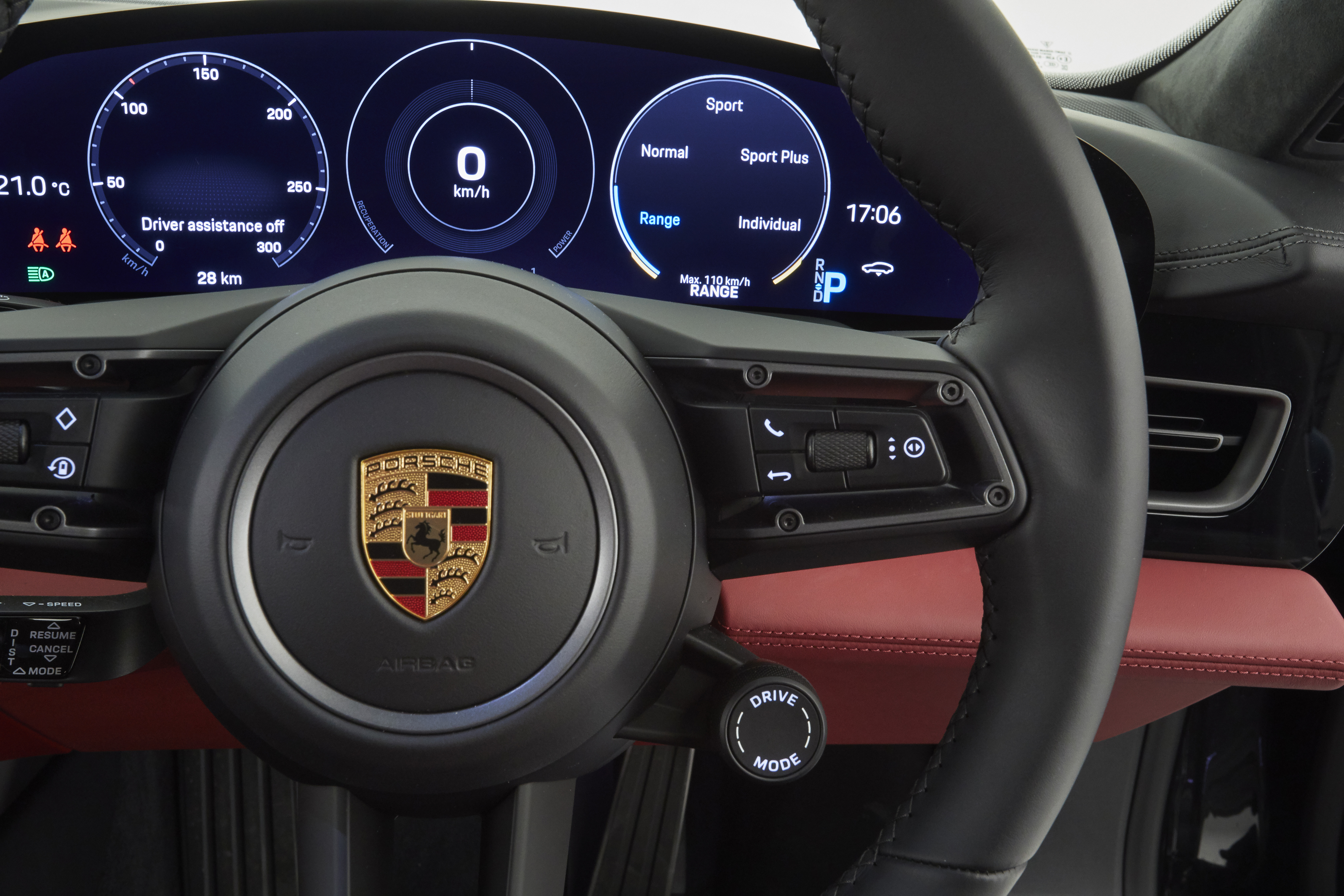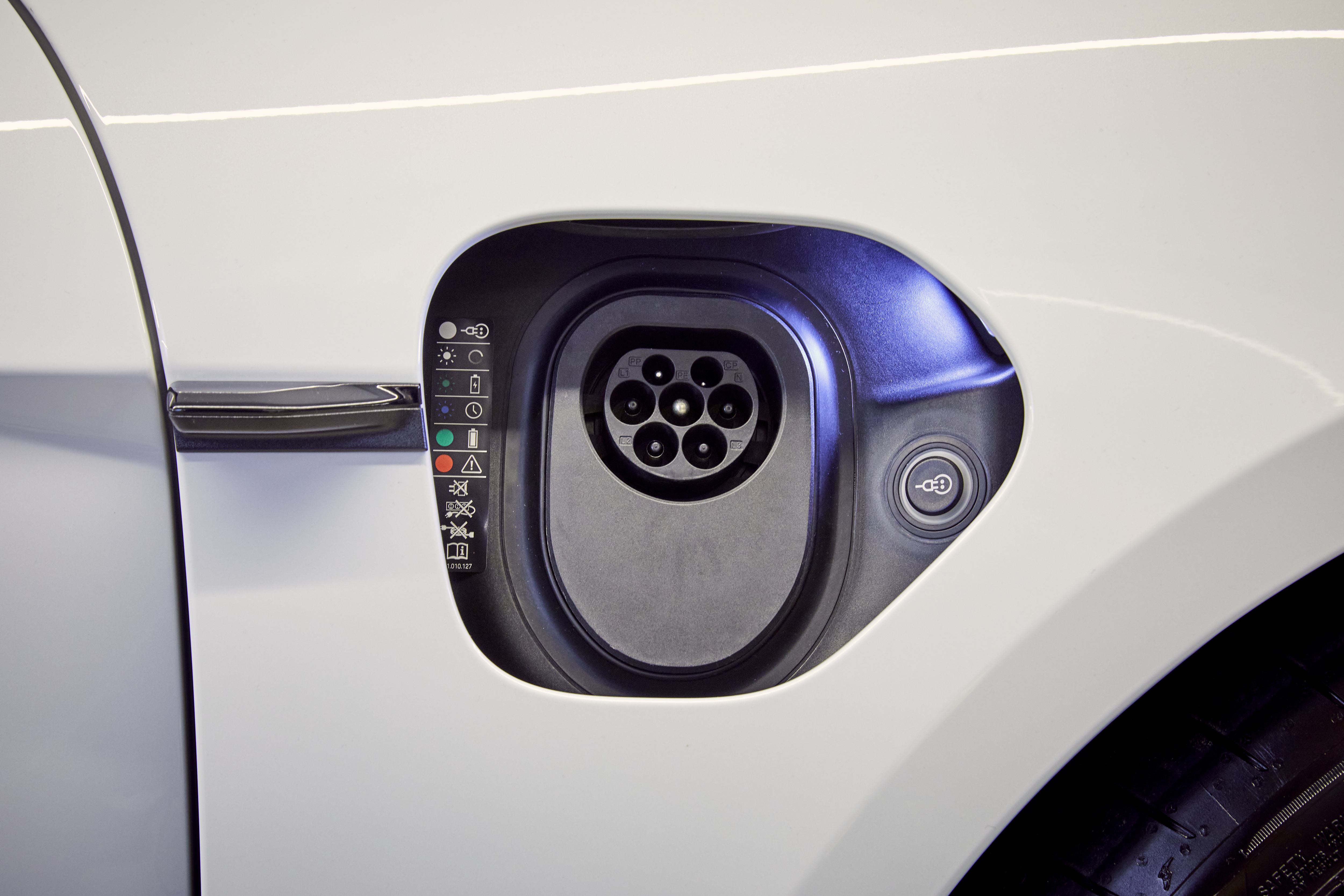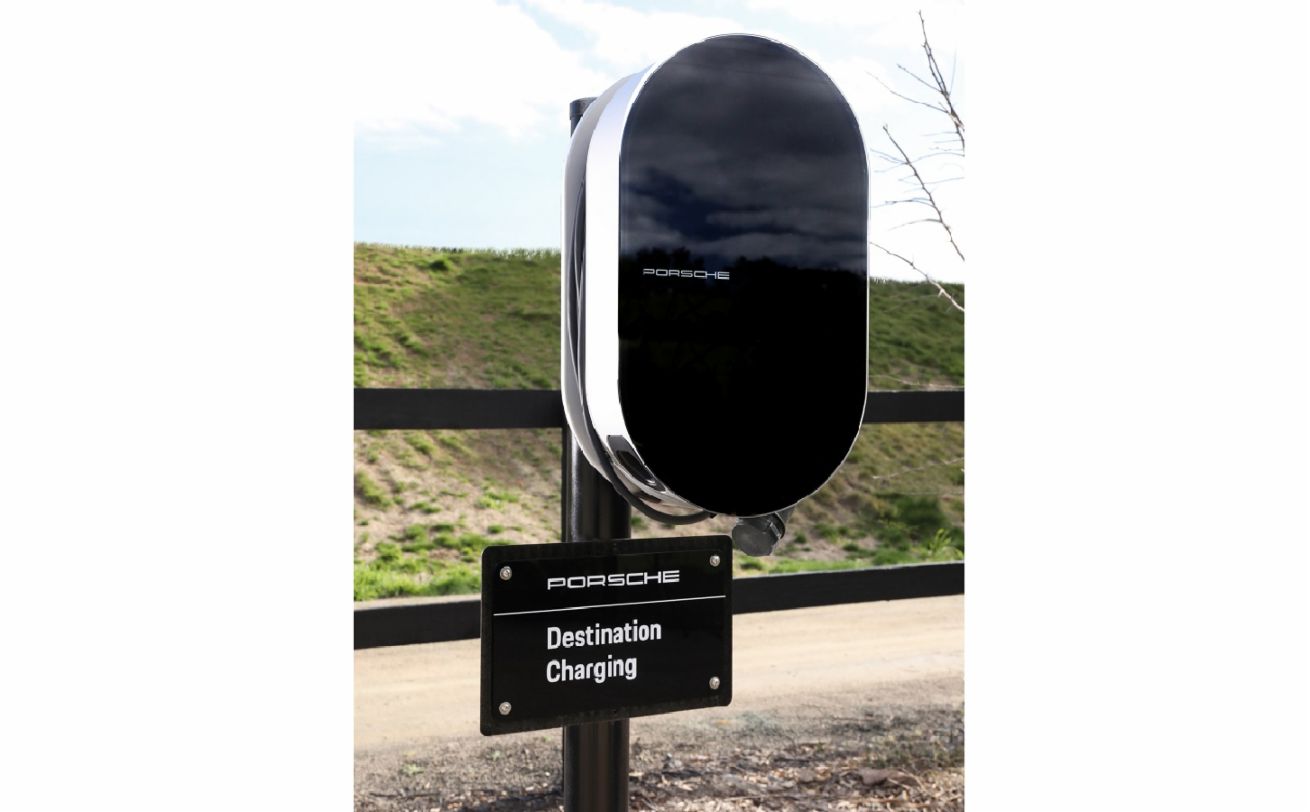Australian model range
From its market release in February 2021, the Porsche Taycan model range in Australia will comprise:
- Taycan Turbo S
- Taycan Turbo
- Taycan 4S
Exterior Design
The Taycan was designed as a fully electric vehicle from the outset. It carries the unmistakeable Porsche design DNA.
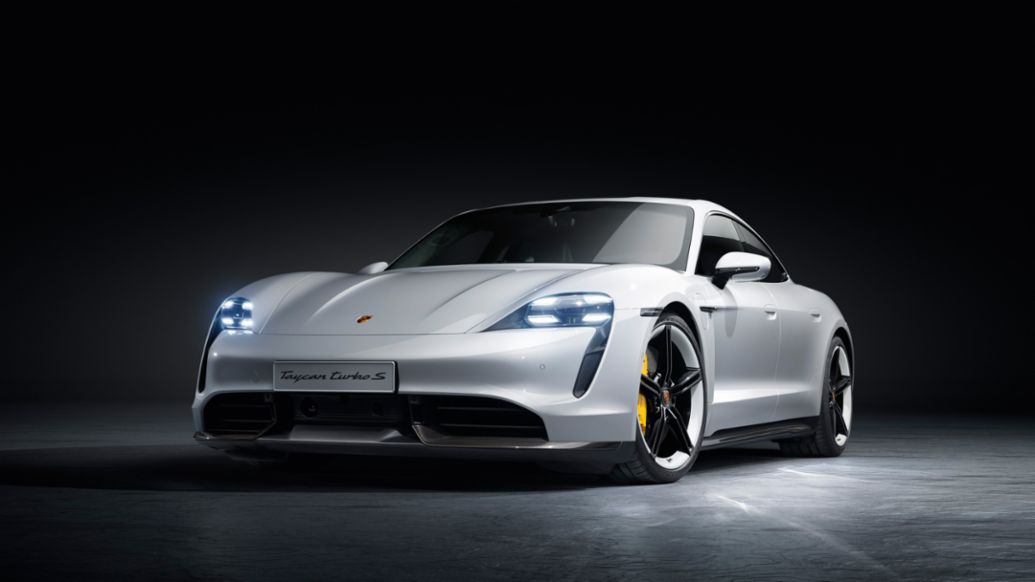
Its silhouette is defined by the sporty roofline that slopes downward to the rear – called the ‘flyline’ by Porsche’s designers.
Other Porsche design characteristics are:
- The highly sculpted side sections
- The sleek cabin (greenhouse) and drawn-in C-pillars
- Sporty, flat front end
- The pronounced shoulders of the wings sharply emphasise the rear
- Low centre of gravity
The dimensions position Taycan between the 911 and the Panamera within the current Porsche model family.
Overall, the Taycan has remained very close to Porsche’s 2015 Mission E concept car.
Interior design
The original 911's cleanly styled dashboard from 1963 was the inspiration for the Taycan’s driver-focused interior.
The stated goal was to bring it into the present day. The Taycan’s cockpit signals the start of a new era with its clear structure and a completely new construction.
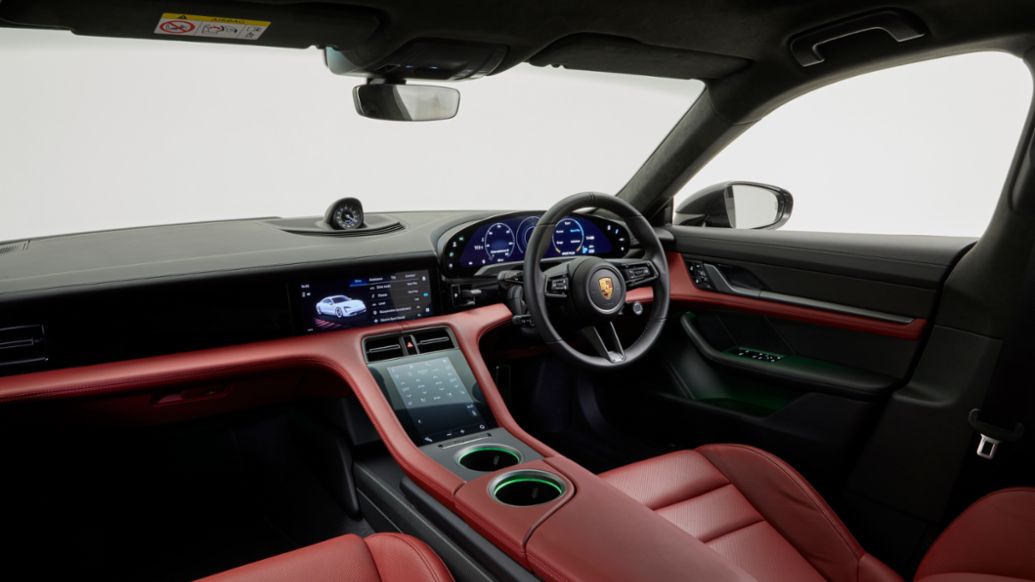
The front seating position is similar to a 911 and the instrument panel has a clean, minimalist and ultra-modern design.
Operating the controls is quick and free from distractions.
The free-standing curved instrument structure is clearly focused on the driver and ensures everything needed is in view.
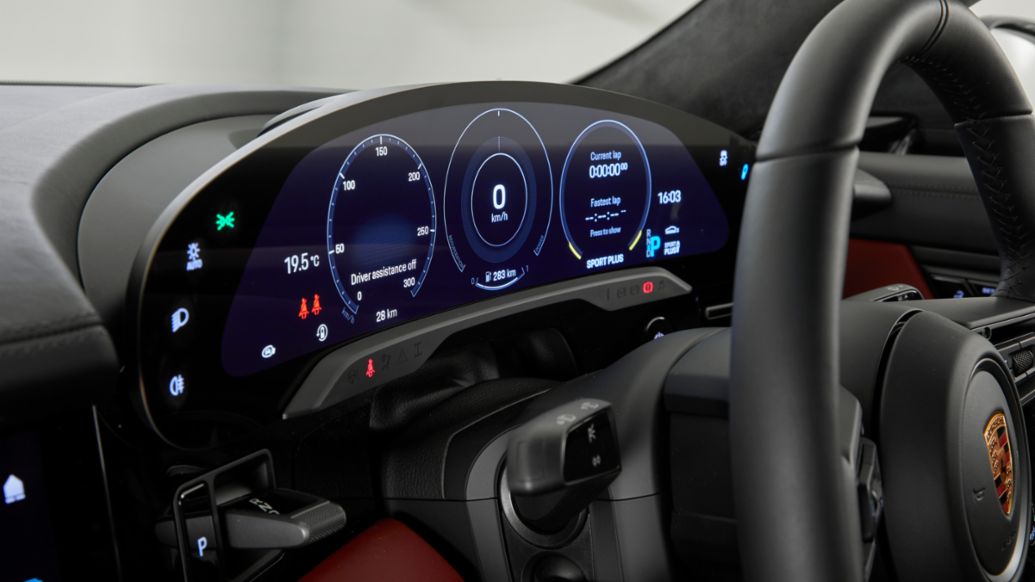
The innovative instrument cluster consists of a 16.8-inch screen with a rounded look typical of Porsche. Its slim and modern appearance is in the style of high-quality smart phones and tablets.
All user interfaces have been completely redesigned, resulting in a reduction of the number of the number of classic hardware controls such as switches and buttons.
Instead, control is intelligent and intuitive – using touch operation or the voice control function, which responds to the command “Hey Porsche”.
All vehicle configurations for the Taycan, such as Porsche Active Suspension Management (PASM), can easily be set up on the central screen via direct access.
The driver can quickly access all apps via a clearly structured and customisable home screen. Apps include navigation, telephone, media, comfort and Porsche Connect.
For the first time, front passengers in the Taycan have the option of their own touch display, allowing them to easily alter settings without distracting the driver.
The elevated centre console intensifies the feeling of a low seating position, as you would expect from a Porsche. It features a large 8.4-inch touch panel with haptic feedback. This allows the air-conditioning settings to be altered directly. Integrated handwriting recognition also allows quick address inputs.
The Taycan has a compact direction selector switch in the instrument panel instead of the classic gear selector lever. This gives the centre console a tidy look and creates storage space.
Innovative material concepts
The Taycan’s colour and material design allows for individualised equipment, from traditional through to sustainable and modern.
There is also the option of classic leather as well as the sustainably tanned Club Leather OLEA, which uses olive leaves in the tanning process.
Optional leather-free interior
A new feature is the fully leather-free interior with state-of-the-art surface textures. It uses Race-Tex material, a high-quality microfibre material partially consisting of recycled polyester fibres. It production has 80 per cent less CO2 than traditional materials.
The floor covering uses the recycled fibre Econyl®, which is made in an innovative production process from items including recycled fishing nets.
Powertrain
The Taycan’s all-wheel-drive (AWD) powertrain comprises 100% newly developed components.

Electric motors
The Porsche Taycan uses two Permanent Magnet Synchronous Motors (PMSM), which feature permanent magnets within a permanent magnetic field.
One motor is located at the rear axle to drive the rear wheels and one is located at the front to drive the front wheels.
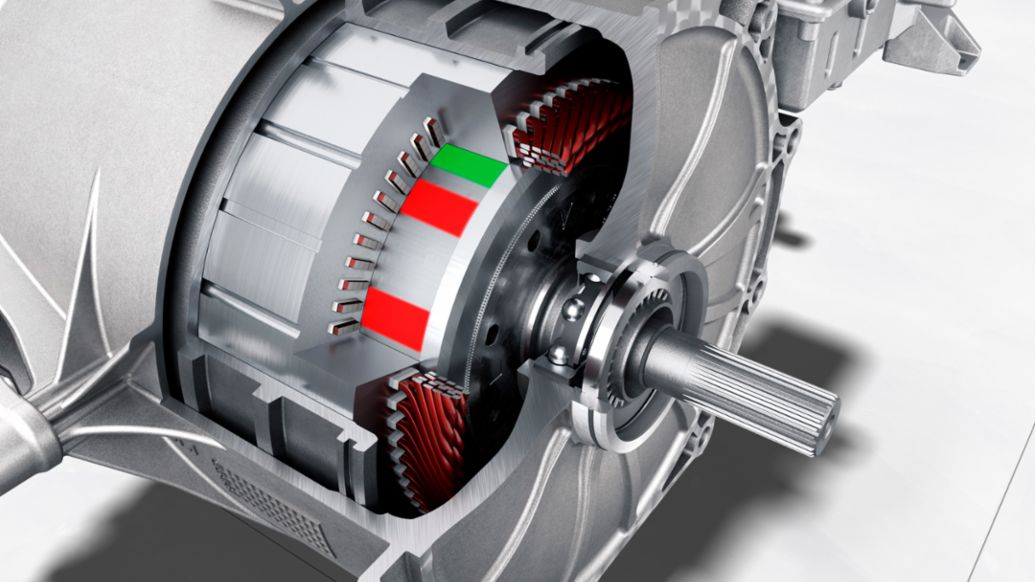
Both electric motors were developed in-house at the Porsche Research and Development (R&D) Centre in Weissach. They are also produced in-house by Porsche.
The Porsche Taycan’s Permanent Magnet Synchronous Motors use hairpin winding technology, which helps produce maximum power density and efficiency. Compared to conventional pull-in windings (used in asynchronous motors), their copper-fill factor is approximately 70% (as opposed to 45%), making them easier to insulate, and they can be cooled more easily.
The compact front axle powerplant comprises:
- A high-performance PMSM electric motor that produces a maximum power output of:
- 190 kW and 400 Nm of torque (Turbo S)
- 175 kW and 300 Nm (Turbo)
- 175 kW and 300 Nm (4S with Performance Battery Plus)
- 150 kW and 300 Nm (4S with Performance Battery)
Its maximum motor speed is 16,000 RPM and it weighs approximately 76kg
- A single-speed transmission in coaxial layout. Its torque capacities are +450 Nm (for traction) and -300 Nm (for recuperation).
It uses two planetary gear sets, it’s cooled using the water jackets of the electric motor, and it weighs only 16 kg thanks to its very compact and short design. - A pulse-controlled inverter with 800-volt technology in two variants: 600 A in Turbo S, 300 A in Turbo and 4S. See the separate section on the pulse-controlled inverter for more details.
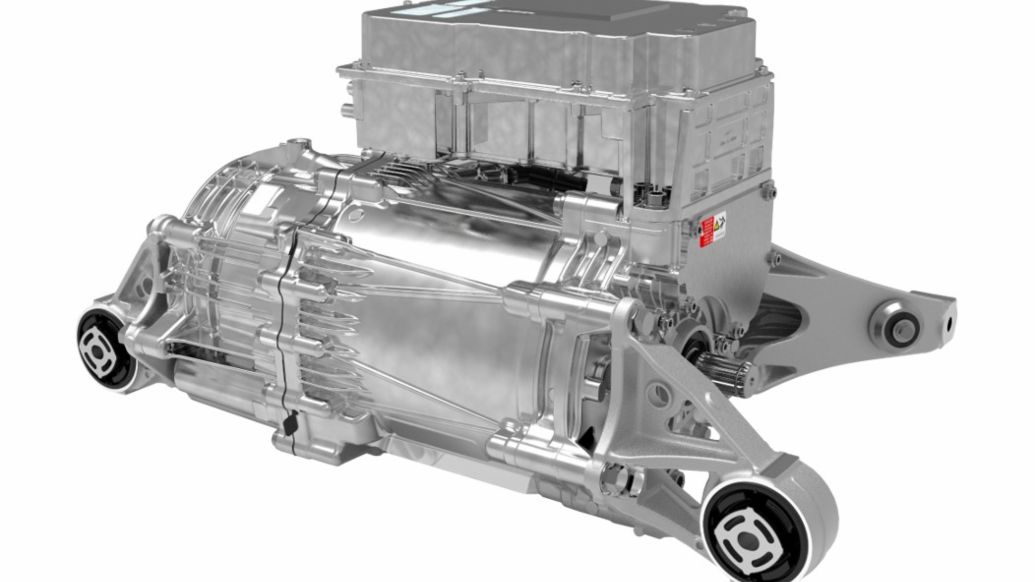
During launch control, the front powerplant delivers up to 440 Nm of torque in the Turbo S, 300 Nm in the Taycan Turbo.
The compact rear axle powerplant module comprises:
- A high-performance PMSM electric motor that produces a maximum power output of 335 kW and 550 Nm of torque for the Turbo S and Turbo models.
- Output for the 4S is as follows: 320 kW and 340 Nm with Performance Battery Plus and 270 kW and 340 Nm without.
- Its motor maximum speed is 16,000 RPM and it weighs 170 kg.
- A compact two-speed transmission
- A pulse-controlled inverter with 800-volt technology
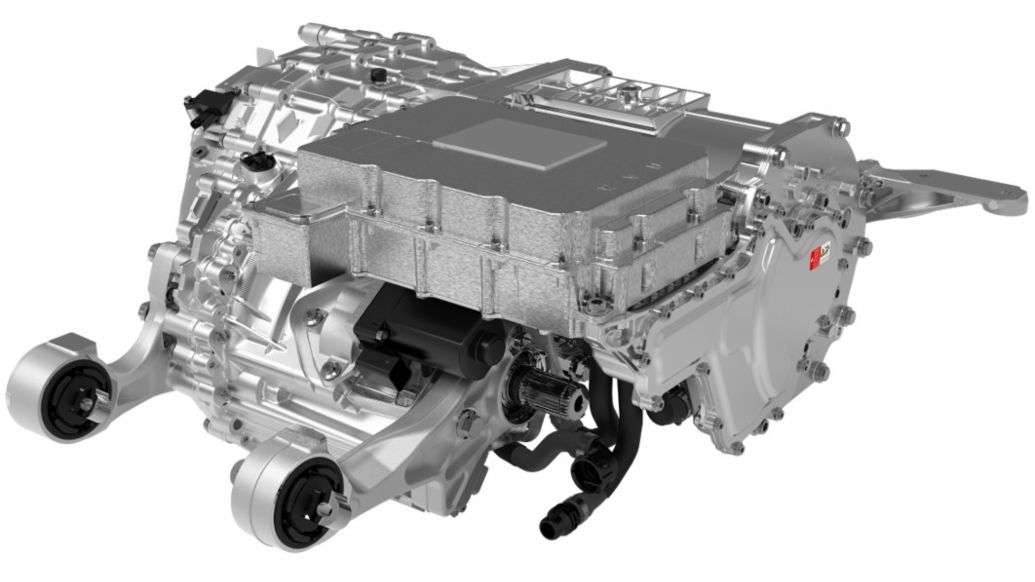
The Taycan’s all-wheel drive provides full variable torque distribution between the front and rear wheels as well as side-to-side, when required.
The distribution of drive torque to the wheels is up to ten times faster for smooth, high-performance acceleration.
When cruising, power and torque distribution is oriented for energy efficiency.
When driving dynamically, power and torque are distributed for traction and pure performance.
When driving in Range mode (see the section titled Four Driving Modes), the electric motors are coupled and de-coupled much faster to preserve battery charge.
Two-speed transmission
The two-speed automatic transmission is located at the rear axle and balances maximum acceleration with efficiency.
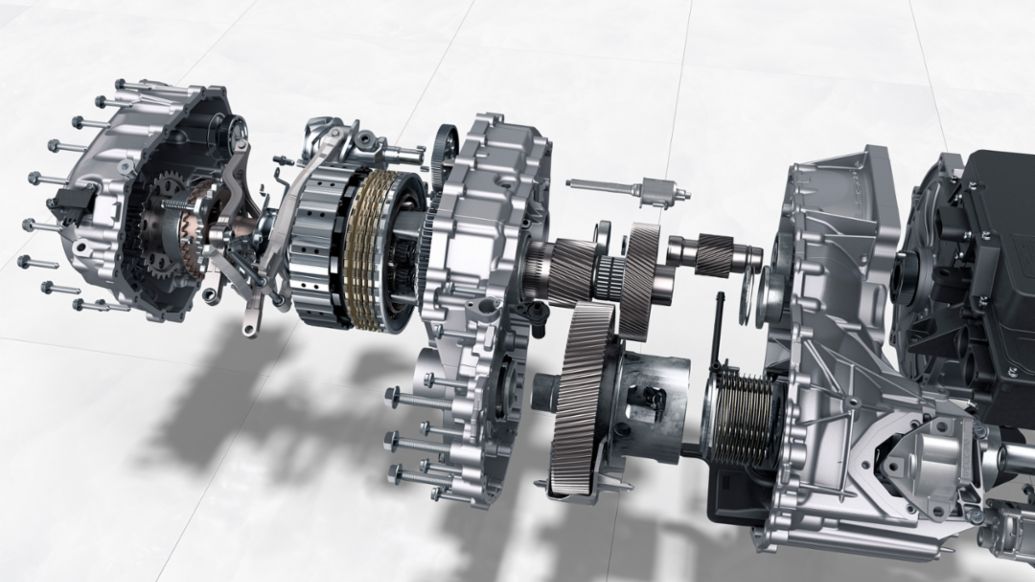
With a maximum torque capacity of 550 Nm and a maximum speed of 16,000 RPM, the two-speed transmission uses a short-ratio first gear to deliver the overboost function for maximum drive-off performance. This is available in the Sport and Sport Plus driving modes.
It uses a long-ratio second gear for maximum efficiency and top-speed.
It uses a single actuator for both the two gear speeds and the parking lock. The design combines two spur gear stages with three shafts.
The two-speed transmission also incorporates an electronically controlled limited-slip differential (see the section titled Porsche Torque Vectoring Plus).
Its compact and flat design means its weight is only 17 kg.
Four driving modes: Range, Normal, Sport, Sport Plus
The profile of the driving modes in the Taycan follows the same philosophy of other Porsche models.
There are four driving modes which can be selected:
- Range:
- This mode enables the longest possible driving range from the Taycan’s available State of Charge (SoC).
- The cooling air flaps (see Porsche Active Aerodynamics), chassis height (-20 millimetres) and rear spoiler are set to achieve minimum drag.
- Air conditioning, hydraulic pumps, air suspension and headlights also operate in their most efficient configurations.
- Range mode enables the most efficient all-wheel power distribution possible.
- In extreme cases, the Taycan will drive using only its front axle.
- Top speed is limited to between 90 km/h and 140 km/h but can be overridden by pressing the accelerator pedal.
- Normal:
- The Taycan delivers its power output in a linear mode in this setting.
- All four wheels are driven in efficiency mode.
- The cooling air flaps only open when necessary, the rear spoiler is adjusted depending on the speed, and the chassis is lowered as required.
- Climate control and adaptive cruise control operate without restriction; the air suspension offers full comfort.
- Sport:
- The highest powertrain performance is delivered in the Sport and Sport Plus modes.
- Driver requests are implemented dynamically.
- The all-wheel drive changes to rear-biased distribution and is dynamically controlled.
- The battery's cooling and heating strategy is designed for performance.
- The cooling air flaps are thermally controlled depending on the required cooling capacity, while the rear spoiler control is speed-dependent.
- The climate control regulates without restriction and the adaptive cruise control is more dynamic (including more powerful acceleration).
- The air suspension lowers the Taycan by up to 22 millimetres (depending on speed), while the suspension, including rear axle steering, is adjusted to a sporty setup.
- Cornering lights’ functionality is also more dynamic.
- Sport Plus:
- ‘Sport Plus’ puts an even more dynamic spin on the driver’s style.
- The battery’s cooling and heating strategy focuses on maximum performance.
- The cooling air flaps are opened, the rear spoiler is extended for minimal lift.
- The chassis setup, including rear axle steering and PDCC, is optimised for maximum race track performance, and the chassis permanently remains in the lowest position (-22 millimetres).
- All the systems available on the powertrain are controlled by the Porsche powertrain controller. This is where all the information is collected and the high-speed actuators are controlled.
- The all-wheel drive and traction control systems operate five times faster than conventional systems.
- If one wheel has more slip, for example, the electric motors regulate it at lightning speed – a particularly impressive experience on snow and ice.
In addition, individual systems can be configured using an ‘Individual’ mode. A prerequisite for the Sport Plus and Individual models is the fitment of the Sport Chrono package.
Launch Control
Launch Control enables maximum acceleration from a stand-still. It’s a standard feature on Taycan. It uses an overboost function where the two electric motors are provided with more power. In the Taycan Turbo S, a power output of up to 560 kW (761 PS*) is delivered during launch control.
Battery
Two battery sizes are available in the Taycan model range:
- Performance Battery Plus: Standard Taycan Turbo and Turbo S (optionally available on the Taycan 4S)
- This battery is a two-deck unit.
- Consists of 396 Lithium-ion pouch cells grouped into 33 modules.
- Voltage level: 610 V – 835 V
- Energy content rating: 93.4 kWh
- Maximum power output: 620 kW
- Performance Battery: Standard on Taycan 4S
- This battery is a single-deck unit.
- Consists of 336 Lithium-ion pouch cells grouped into 28 modules.
- Voltage level: 520 V – 720 V
- Energy content rating: 79.2 kWh
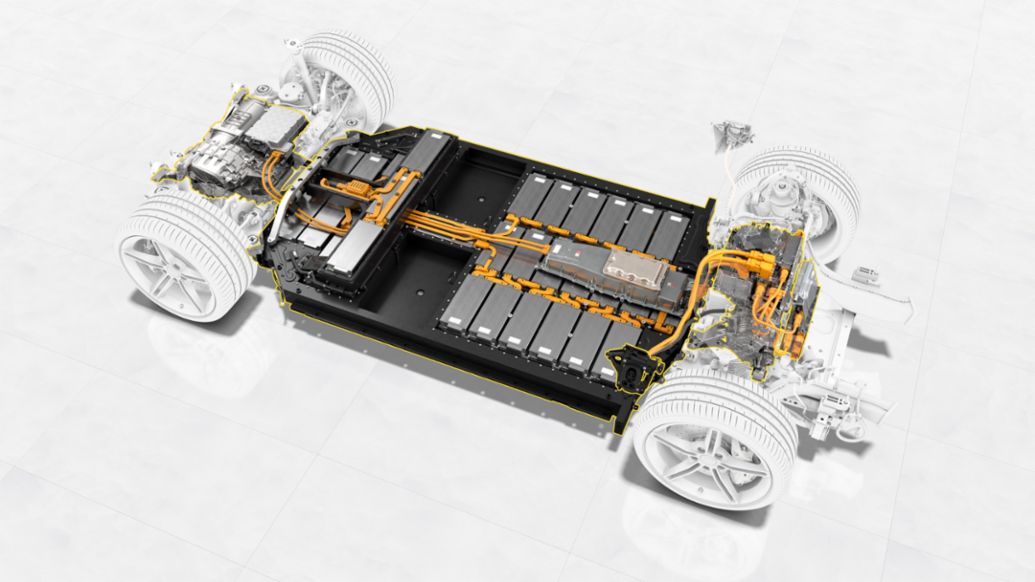
The Porsche Taycan’s high-voltage battery is a flat under-body unit that’s mounted low in the vehicle to optimise the Taycan’s overall centre of gravity.
‘Foot garages’ – recesses in the battery in the rear-passenger footwell – ensure a comfortable seating position for rear-seat passengers.
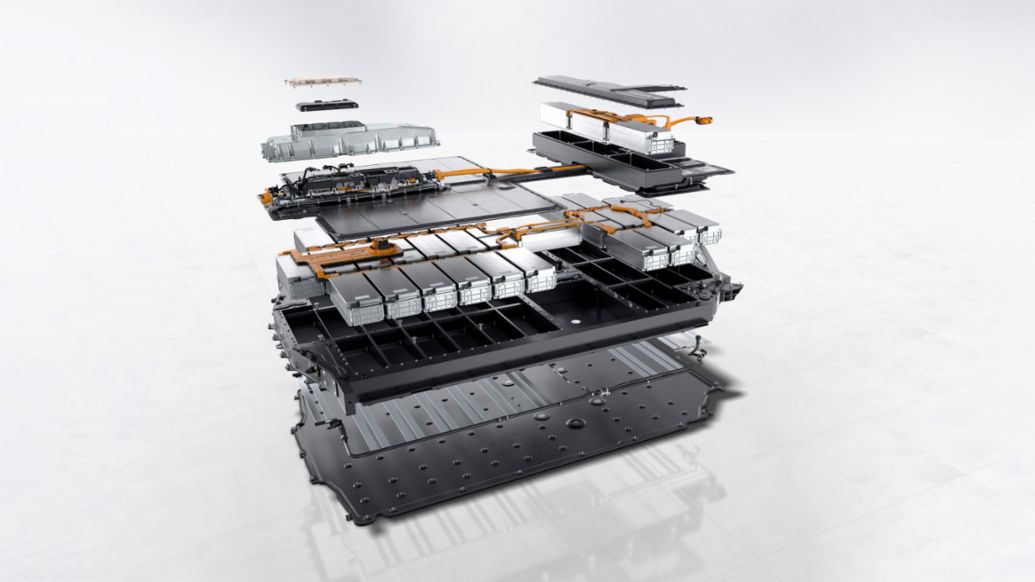
The battery’s mounting frame is an integral component of the vehicle structure.
Thermal management
The battery is integrated into the vehicle's cooling circuit via a line system and a coolant pump. It can be cooled or heated so that it always operates in an ideal temperature window.
The cooling elements have been placed outside the actual battery box and are glued to its underside to allow heat transfer.
The battery can also store the waste heat from the liquid-cooled high-voltage components. As a result, it serves as a thermal storage device or buffer, which permits intelligent functions such as conditioning to ensure driving performance.
The target temperature of the battery is determined on the basis of the battery charge and the selected driving program. This ensures sporty driving performance and allows Launch Control to be used.
Predictive power consumption
The vehicle also predicts the electrical power consumption of the air-conditioning system and the conditioning of the components based on the outside temperature, humidity and sunshine, as well as the currently selected driving program and the respective setting of the automatic climate control system. The current range is calculated using these figures.
Inverters (pulse-controlled):
The Porsche Taycan uses two pulse-controlled inverters – one located at each axle for each electric motor.
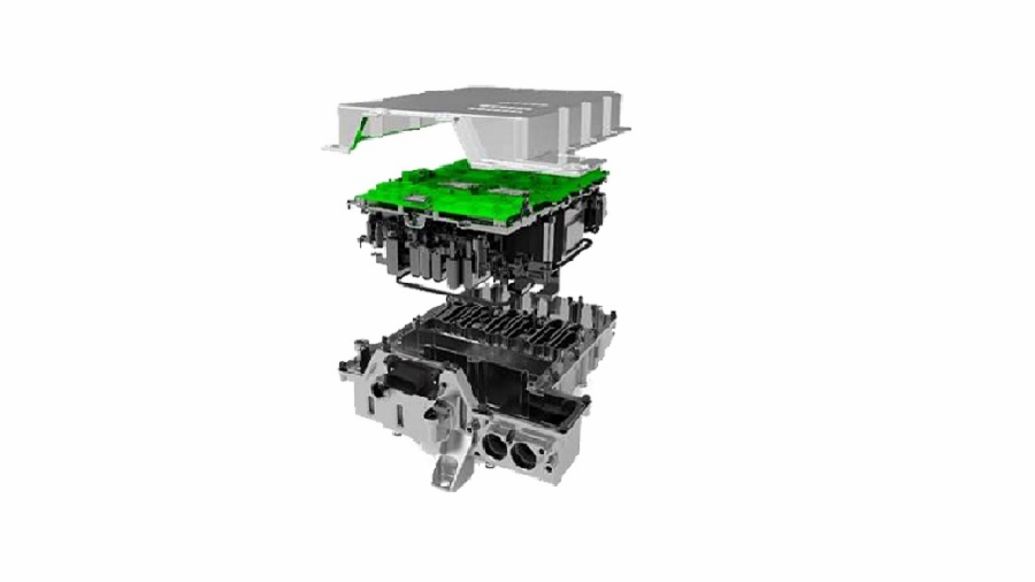
These pulse-controlled inverters operate as the control centre between the battery and the electric motors. They convert DC power to AC power and are highly efficient (up to 98.5%).
For the Taycan Turbo S they deliver 600A of current; for the Taycan Turbo and Taycan 4S this is 300A.
The Taycan’s pulse-controlled inverters operate in reverse during recuperation (during deceleration and braking, when the electric motors are used to generate power for the battery), producing up to 265 kW in regeneration mode – far exceeding other commercially available electric cars.
800 Volt Electrical Architecture
The Porsche Taycan model range uses a system voltage of 800 Volts, the first for a production vehicle.
A system voltage of 800 Volts (over the conventional 400 Volts) enables faster battery charging, higher continuous power, and decreases the weight of the system’s cabling.
A voltage level of 800 V also allows for future performance upgrades with regard to charging power.
Recuperation
Brake energy recuperation, also known as regeneration, occurs when an EV decelerates or slows down when braking.
It occurs when the car’s kinetic energy (its motion when driven) is converted back into electrical energy during deceleration by using its onboard electric motors to operate as generators. The energy they generate is then stored in the car’s onboard battery.
The Porsche Taycan has a maximum recuperation power of 265 kW, even under high-performance driving conditions – making it best in-class.
Around 90% of all braking events when driving the Taycan are covered through recuperation, which means brake pad life can be dramatically increased.
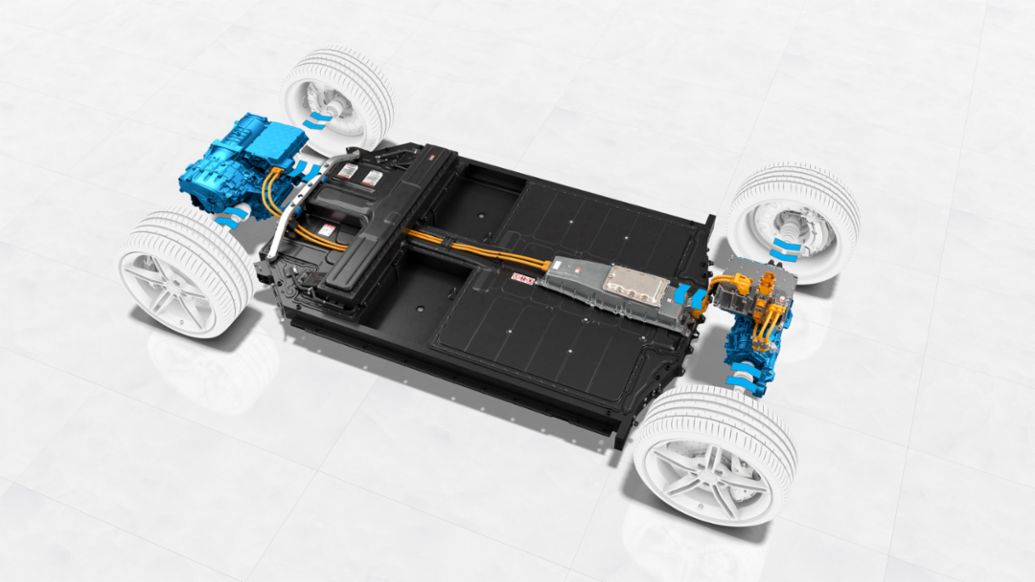
Porsche’s approach to recuperation with the Taycan has resulted in comfortable and efficient coasting but with the highest level of brake pedal recuperation. This means when lifting off the accelerator pedal the Taycan behaves like a conventional sports car, avoiding sudden ‘head-toss’ braking-like deceleration.
Braking behaviour in the Taycan is consistent, whether the battery is cold, hot, full, or approaching empty.
Charging the Taycan
Charging the Porsche Taycan is simple. A summary is shown in this short video.
The Taycan’s 800 Volt electrical architecture enables high-performance battery charging, faster than a conventional 400 V system.
Peak Charging power:
- Taycan Turbo S and Taycan Turbo: 270 kW (Performance Plus Battery)
- Taycan 4s: 225 kW (Performance Battery)
(By comparison, a 400 V system typically offers a peak charging power of 150 kW.)
Charging Ports:
There are two recharging ports on the Taycan, one on each side of the car. Located behind their charge port doors (which resemble conventional fuel doors), they are just forward of the front doors.
AC charging can occur using both sides of the car, with the DC charging port located on the car’s left-side (front-passenger side).
The Turbo S is fitted with an electric charge port door. This can be opened from outside by either a gesture sensor or from inside the car using a button on the centre console.
The electric charge port door disappears completely inside the front wing when opened. Its design is robust and can resist the build-up of ice, excessive force, and vandalism.
The Taycan uses a Type 2/CCS plug for recharging.
Charging Infrastructure:
In Australia, owners will have several ways to charge their Taycan, including High Performance Charging, Home Charging and Porsche Destination Charging.
- High Performance Charging:
Porsche Cars Australia has partnered with Chargefox, Australia’s largest EV charging network operator.
Taycan owners will receive a complimentary three-year subscription to the Chargefox Ultra-Rapid DC charging network (up to 350 kW), and complimentary charging at selected Chargefox-managed Fast DC charging sites (mostly 50 kW)&.
The complimentary subscription period begins on delivery of the vehicle. Owners can download the Chargefox app via Google Play or the Apple App Store.
- Home Charging:
When purchasing a Taycan in Australia, Porsche Centre sales consultants are able to arrange a Home Check service in order to determine installation requirements for charging at home. For this, Porsche Centres have partnered with JET Charge who can deliver expert advice on home charging solutions.
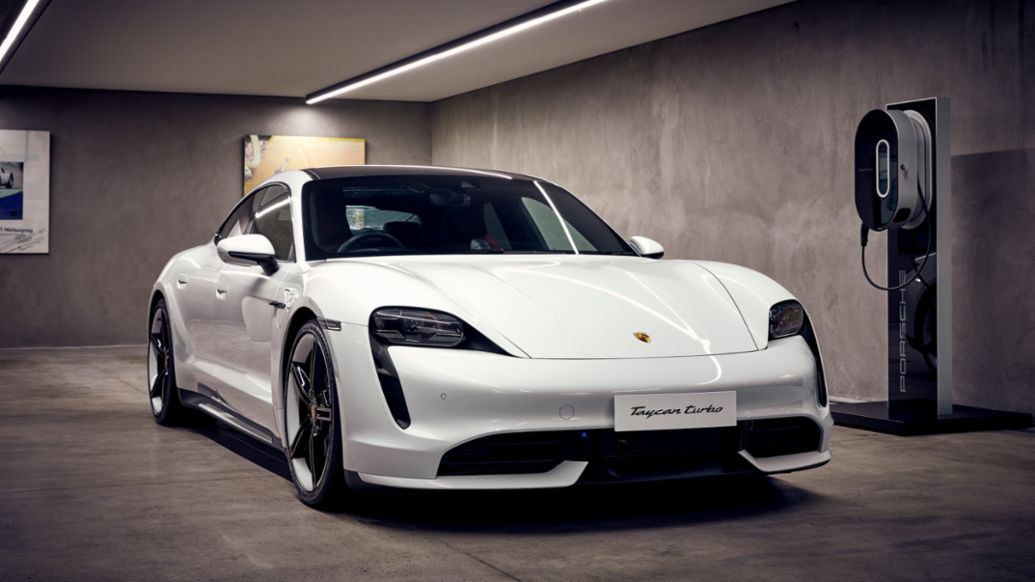
The Home Energy Manager, included with the purchase of a Taycan, can dynamically optimise the charging process in terms of performance, time and costs. This item, when correctly integrated into the owner’s domestic power network, continually monitors the power requirements of the Taycan and the available output of the power supply when it’s being recharged.
- Porsche Destination Charging:
When on the road, the Taycan, as well as Porsche plug-in hybrid models, benefits from the expanding Porsche Destination Charging network being installed across metropolitan and regional sites in Australia.
Porsche Destination Chargers give owners access to complimentary charging of Porsche models.
Porsche Destination Charging will continue to be installed at premium lifestyle destinations such as luxury hotels, theatres and entertainment venues, restaurants, shopping precincts and cellar door locations.
Porsche owners are encouraged to visit the Porsche Destination Charging network section online to find charging locations as the network continues to grow. As chargers are activated, they will be added to the Taycan’s in-car navigation system as an over-the-air update.
Charging: Standard Equipment Inclusions:
- 150kW on-board DC-Charger (for when recharging at public charging stations)
- Home Energy Manager (monitors the Taycan’s recharging needs and the available output of the power supply)
- 22kW Mobile Charger Connect module (cable connection between control unit and vehicle with a length of 2.5 metres)
- Porsche Charging Dock
- Charging cable for domestic sockets
- Public charging cable (Mode 3) with 4.5 metre length
- Supply cable for Red industrial electrical outlets (400 V, 32 A, 5 Pin)
- Supply cable for Blue industrial electrical outlets (230 V, 32 A, 3 Pin)
- Three year subscription to the Chargefox electric vehicle network, which includes free charging on the Chargefox Ultra-Rapid charging network (350kW).&
Recharging times:
|
|
Taycan Turbo S |
Taycan Turbo |
Taycan 4S |
|
Maximum DC charging capacity |
270 kW |
270 kW |
225 kW / 270 kW1 |
|
AC at 11 kW: 0-100% |
9 hours |
9 hours |
8 hours |
|
DC at 50 kW: 5-80% SoC |
93 minutes |
93 minutes |
93 minutes |
|
DC at 270 kW: 5-80% SoC (optimum conditions) |
22.5 minutes |
22.5 minutes |
22.5 minutes |
SoC: state of charge
1 When fitted with the optional Performance Battery Plus
Range:
|
|
Taycan Turbo S |
Taycan Turbo |
Taycan 4S |
|
Range# |
405 km# |
420 km# |
365 km# (414 km#)1 |
1 When fitted with the optional Performance Battery Plus
Performance
Taycan Turbo S
The flagship Taycan Turbo S can generate up to 560 kW / 761 PS* of overboost power and 1,050 Nm of torque in combination with Launch Control.
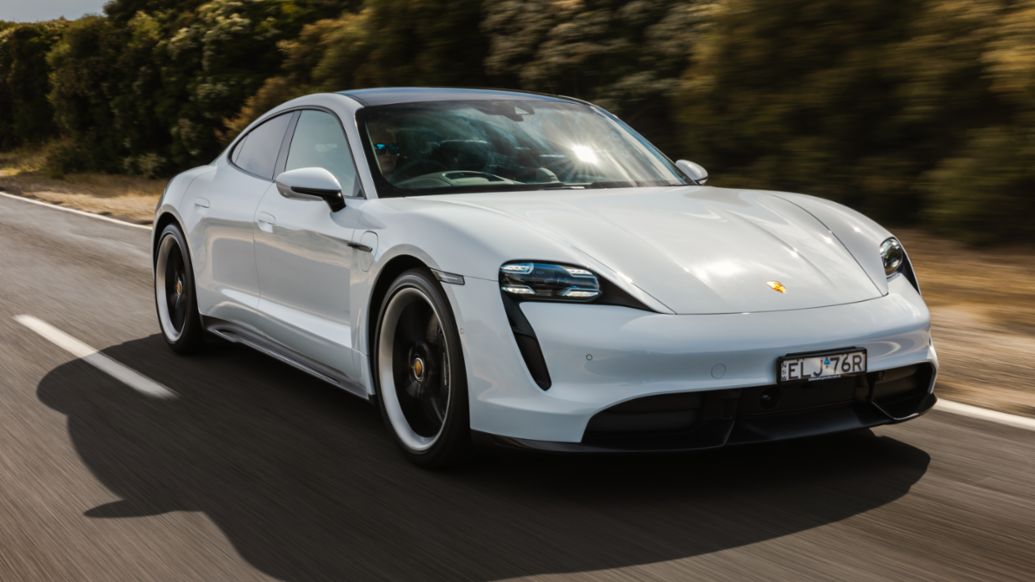
The Taycan Turbo S accelerates from zero to 100 km/h in just 2.8 seconds, the same acceleration figures as the 911 GT2 RS (type 991.2).
The top speed of the Turbo S is 260 km/h.
It has a combined range of up to 405 km# when the battery is fully charged.
Taycan Turbo
The Taycan Turbo generates up to 500 kW / 680 PS* (metric horsepower) of overboost power and 850 Nm of torque in combination with Launch Control.
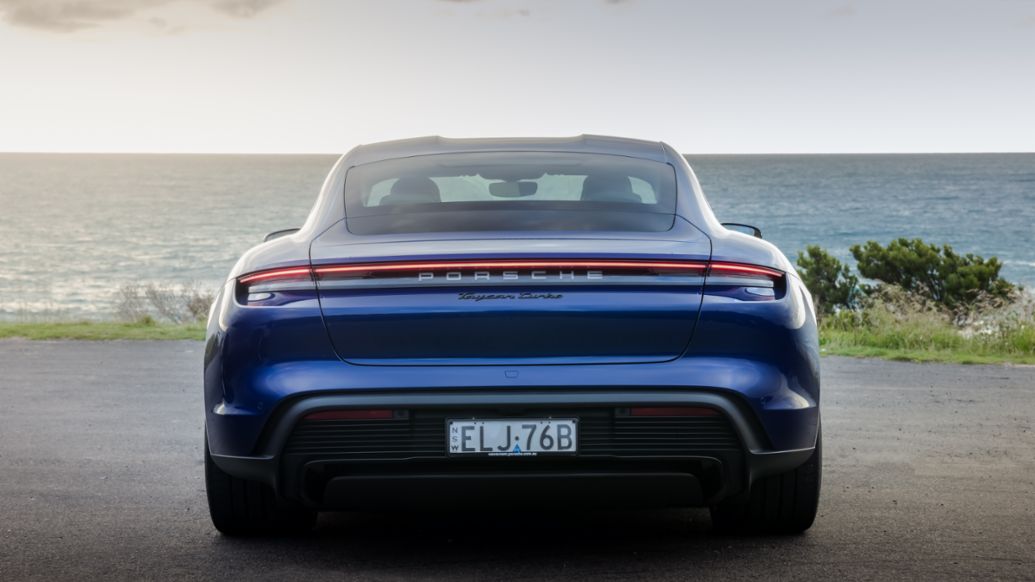
It completes the zero to 100 km/h sprint in 3.2 seconds. The top speed of the Taycan Turbo is 260 km/h. It has a combined range of up to 420 km# when the battery is fully charged.
Taycan 4S
The Taycan 4S produces up to 390 kW / 530 PS* (metric horsepower) of overboost power and 640 Nm of torque in combination with Launch Control.
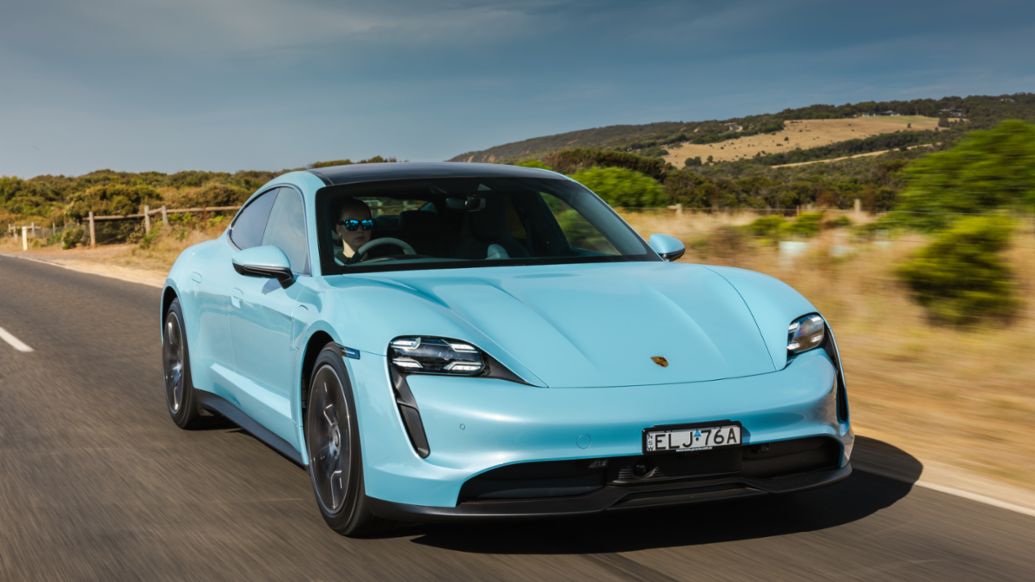
The Taycan 4S accelerates from a standing start to 100 km/h in 4.0 seconds.
The Taycan 4S has a top speed of 250 km/h.
It has a combined range of up to 365 km# when the battery is fully charged.
The Performance Battery Plus package on the Taycan 4S is available as an option. It increases battery capacity to 93.4 kWh, resulting in a notable performance increase of up to 420 kW / 571 PS* (horsepower) of power and 650 Nm of torque, as well as an increased combined range of 414 km#.
|
|
Taycan Turbo S |
Taycan Turbo |
Taycan 4S |
|
Power output |
460 kW |
460kW |
320 kW (360 kW1) |
|
Overboost power |
560 kW |
500 kW |
390 kW (420 kW1) |
|
System torque |
1,050 Nm |
850 Nm |
640 Nm (650 Nm1) |
|
0-100 km/h |
2.8 s |
3.2 s |
4.0 s |
|
0-200 km/h |
9.6 s |
10.6 s |
13.3 s (12.9 s1) |
|
0-400 m |
10.7 s |
11.1 s |
12.3 s (12.2 s1) |
|
Repeatability |
>10x |
>10x |
>10x |
|
Top speed |
260 km/h |
260 km/h |
250 km/h |
|
Range# |
405 km# |
420 km# |
365 km# (414 km#)1 |
1 When fitted with the optional Performance Battery Plus
Performance testing highlights
- At Lahr Airfield in Germany, the Taycan performed 26 separate 0-200 km/h launch control acceleration tests in quick succession. Each recorded time was under ten seconds. The time difference between the first and last acceleration tests was less than one second.
- The Taycan completed 3,425 km of high-speed driving over 24 consecutive hours at the Nardo testing facility in Italy. The average speed achieved was 143 km/h. This test included recharging stops.
- The Taycan has recorded a lap time of 7 minutes and 42 seconds at the Nürburgring Nordschleife, making it officially the fastest battery electric vehicle (BEV) sports sedan at this circuit.
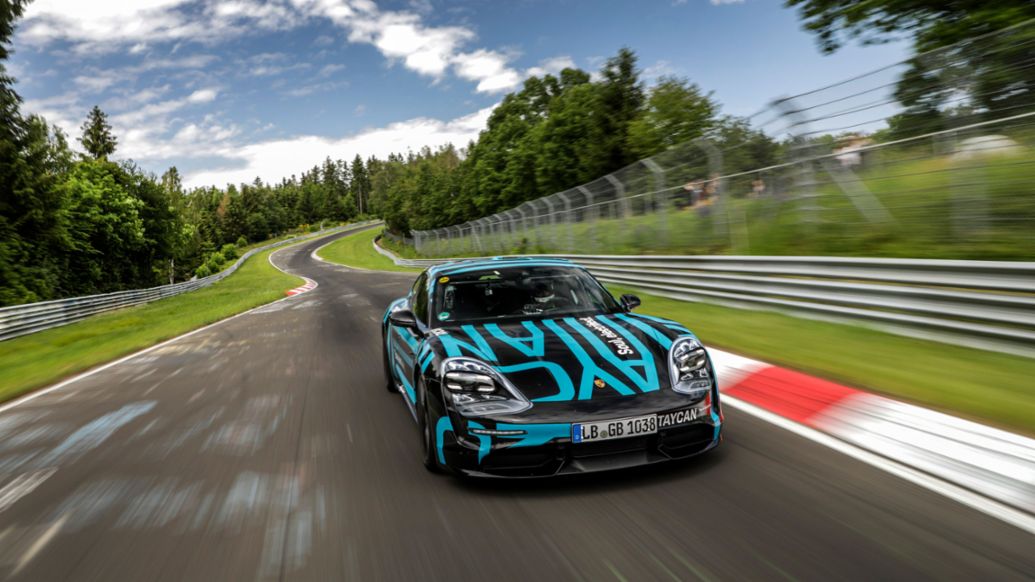
Chassis and Suspension
Layout
Front: The Taycan uses a double-wishbone design with forged aluminium wishbones and hollow-cast aluminium lightweight swivel bearings.
Rear: Multi-link axle with forged upper aluminium wishbones and hollow-cast aluminium lower wishbones.
The Porsche Taycan has a static weight distribution of 49 / 51 front to rear.
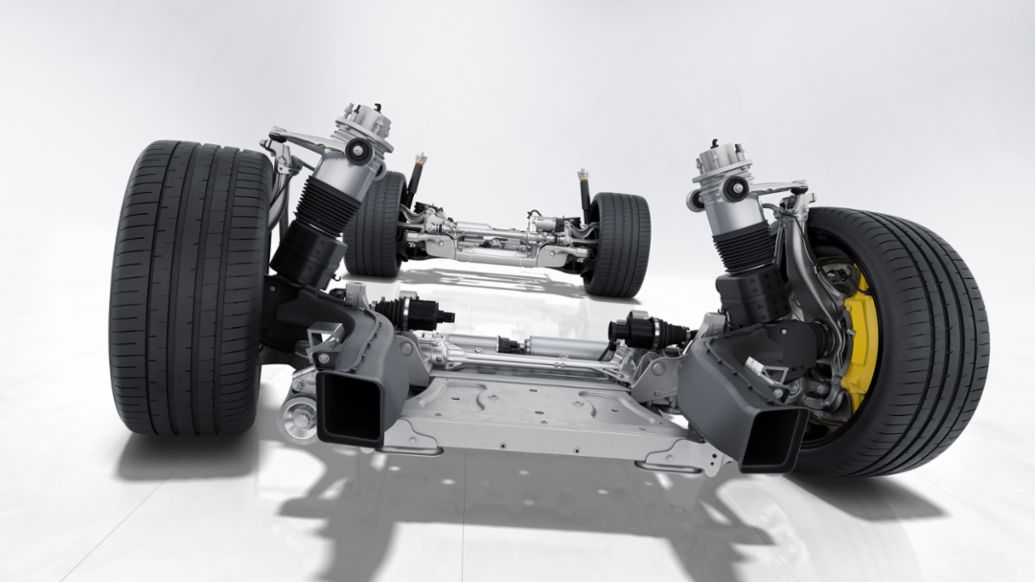
Porsche 4D-Chassis Control: intelligent command centre
Porsche uses a centrally controlled network system for the Taycan’s chassis.
This means it analyses the current driving situation in all three dimensions (longitudinal, lateral and vertical acceleration) and shares the calculated vehicle status with the Taycan’s chassis system in real-time – making it the fourth dimension in chassis control.
This means the Taycan’s chassis systems provide integrated responses to the driving situation.
Porsche Active Suspension Management (PASM)
The Porsche Active Suspension Management (PASM) electronic shock absorber control system responds to the road surface conditions and the current driving style, constantly adjusting damping for each individual wheel accordingly.
Drivers can choose from four driving modes: Range, Normal, Sport and Sport Plus (see Driving Modes for more details on each).
PASM uses sensors to record the body movements generated during fast acceleration, braking, fast cornering or driving on uneven road surfaces. PASM then sends the recorded data to the Porsche 4D Chassis Control. This command centre calculates the current vehicle status and regulates the damper characteristics and spring rates depending on the selected mode.
Thanks to the three-chamber air suspension technology (see 3-Chamber air suspension), different air suspension volumes can be switched within milliseconds.
The 4D Chassis Control system also allows the control parameters of the other electronic suspension systems to be adjusted accordingly. The noticeable result: more driving stability, performance and comfort.
3 Chamber air suspension
The Porsche Taycan uses an all-new 3 Chamber air spring system that enables a variety of spring rates. This means the chassis can be adjusted to a low spring rate for driving comfort and – as soon as it’s needed – the spring rate can be electronically adjusted in a fraction of a second for accelerating and braking.
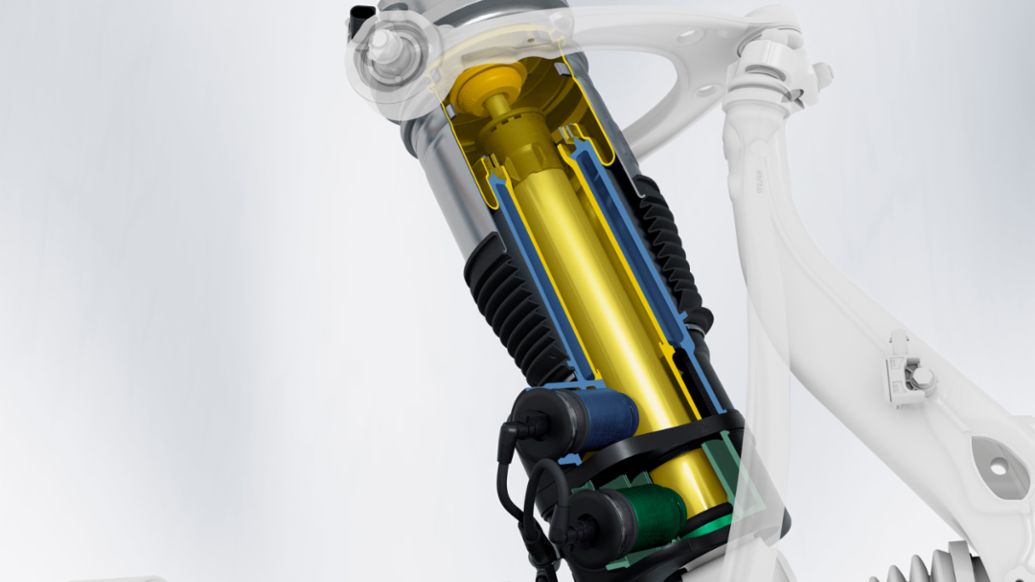
Roll movements are reduced via volume control of the air within each spring chamber.
The Taycan’s 3 Chamber air spring system provides a high ratio between soft comfort and racetrack-levels of stiffness.
It also gives advantages with ride height control. It keeps the Taycan at the same height or the desired level regardless of its load.
The air spring system can also help change the Taycan’s frontal area in two stages, optimising the driving range.
Three further levels are available in addition to the standard height level, depending on the driving mode. When driving in Range and Sport Plus, the chassis is always at its lowest (-22 millimetres).
Additional features of the Taycan’s air spring system include:
- The lift level raises the chassis by 20 millimetres to help prevent the front spoiler from bottoming, such as when entering an underground car park. This height can be maintained up to 30 km/h.
- From a speed of 90 km/h, the Taycan is lowered by 10 millimetres.
- When 180 km/h is reached, the body lowers by 22 millimetres to improve road holding and aerodynamics.
Porsche Stability Management (PSM)
Porsche Stability Management (PSM) has three modes on the Taycan:
- PSM ON: The default setting
- PSM SPORT: Which allows a controlled level of lateral movement and operates like ‘an elastic band’
- PSM OFF: Full system deactivation
Porsche Dynamic Chassis Control (PDCC)
Porsche Dynamic Chassis Control Sport (PDCC Sport) is Porsche’s active roll stabilisation system.
It uses electromechanical anti-roll bars.
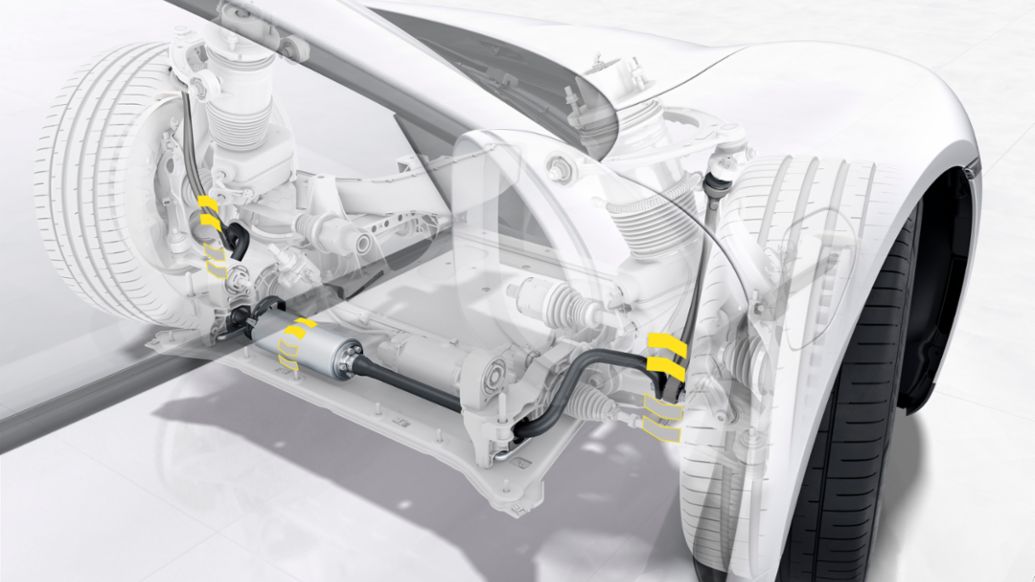
When required, the system reacts in just 200 milliseconds in order to stiffen the anti-roll bars to prevent the body from rolling, helping to control understeer / oversteer.
This makes PDCC more than 30 per cent faster than similar systems using hydraulic actuators.
A further advantage is the lower energy consumption of the system, which is particularly important for an electric vehicle and allows the electric range to be optimised.
PDCC will reduce body roll angles all the way to approximately zero degrees, even under full lateral acceleration.
PDCC also minimises road surface-induced body roll acceleration by active compensation between the Taycan’s left track and right track.
Porsche Torque Vectoring Plus (PTV Plus)
Porsche Torque Vectoring Plus (PTV Plus) uses an electronically controlled differential lock on the rear axle to vary the drive torque between the rear wheels.
Additional yaw torque can be generated on the rear axle by braking the inner wheel when cornering. This ensures that the vehicle's steering response is even more agile.
It also improves traction by specifically locking the differential when accelerating out of corners.
Rear-axle steering
Rear-axle steering is available on the Taycan and enables impressive steering precision.
At low speeds of up to about 50 km/h, the rear wheels steer in the opposite direction to the front wheels. The steering angle depends on the driving speed and is a maximum of 2.8 degrees. This virtual shortening of the wheelbase results in a more dynamic steering response when cornering.
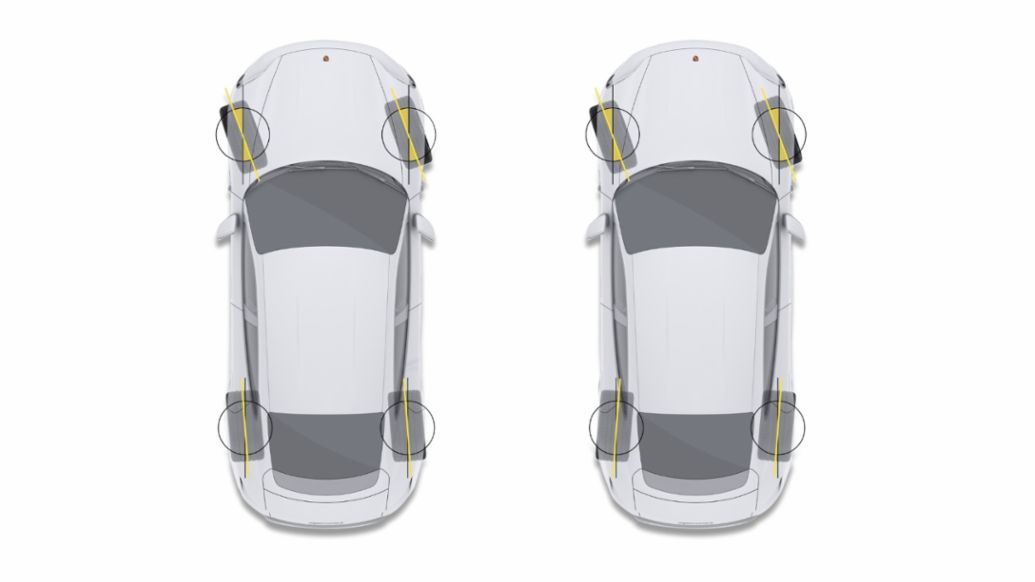
It also makes manoeuvring easier as the turning circle reduces by around 60 centimetres to 11.2 metres.
In addition, with rear-axle steering, the Taycan automatically features Power Steering Plus with greater support for steering assistance at low speeds.
At speeds exceeding approximately 50 km/h, the rear wheels steer in the same direction as the front axle, again depending on the speed. The wheelbase is therefore virtually lengthened, thereby increasing stability, for example when changing lanes on a motorway.
Porsche performance brakes
- Taycan Turbo S:
The top braking system is the Porsche Ceramic Composite Brake (PCCB), standard for the Taycan Turbo S and optionally available for the Taycan Turbo and 4S.
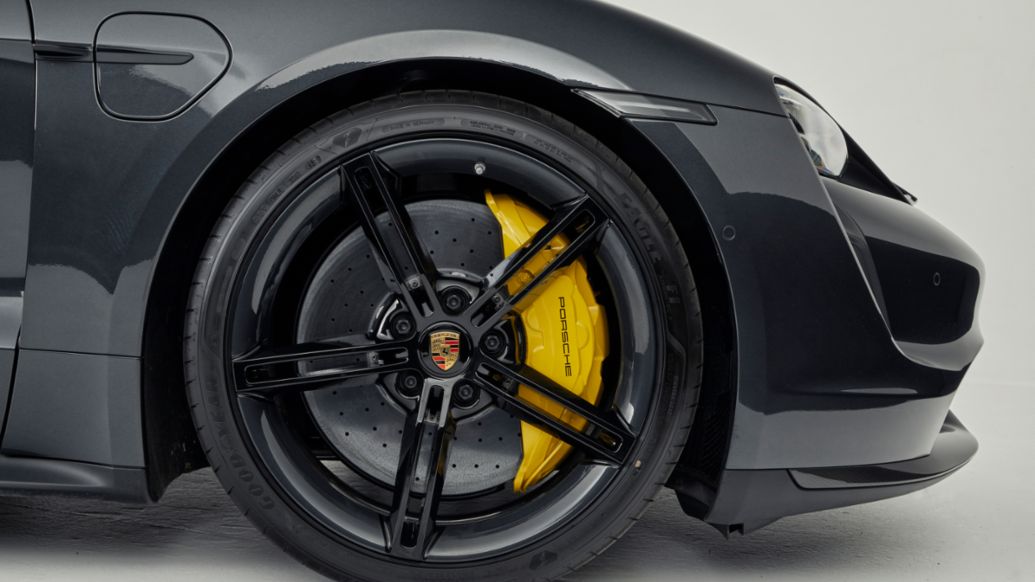
The lightweight ceramic composite brake discs are 420 millimetres (front) and 410 millimetres (rear) in diameter.
The Turbo and Turbo S have ten-piston, aluminium monobloc fixed-caliper brakes at the front. Four-piston calipers are used at the rear.
The calipers are painted yellow on the Taycan Turbo S.
- Taycan Turbo:
The Taycan Turbo is equipped with the high-performance Porsche Surface Coated Brake (PSCB) as standard.
The tungsten carbide layer applied to the grey cast iron discs increases braking performance and wear resistance. They also reduce the amount of brake dust produced (which make a vehicle’s rims dirty.)
The brake disc diameters are 415 millimetres (front) and 365 millimetres (rear).
Like the Turbo S, the Taycan Turbo uses ten-piston aluminium monobloc fixed-caliper brakes at the front. Four-piston calipers are used at the rear.
The calipers are painted white on the Taycan Turbo.
- Taycan 4S:
The Taycan 4S uses six-piston fixed-calipers on the front axle and four-piston calipers on the rear, with internally vented cast iron brake rotors.
The brake rotor diameters are 360 millimetres (front) and 358 millimetres (rear).
The calipers are painted red on the Taycan 4S.
Safety
The Porsche Taycan has a newly designed high-tech lightweight body which accommodates the electric powertrain and onboard battery.
All components have been designed and optimised for lightweight construction.
The high-voltage battery with its internal load paths is cleverly integrated into the bodyshell structure. The battery modules are built into the battery frame in such a way that maximum passive and high-voltage safety is achieved in the event of a crash.
The battery frame is a seal-welded lightweight aluminium structure. A truss within the rigid all-around frame along with crash box elements combine to protect the battery in the event of an impact.
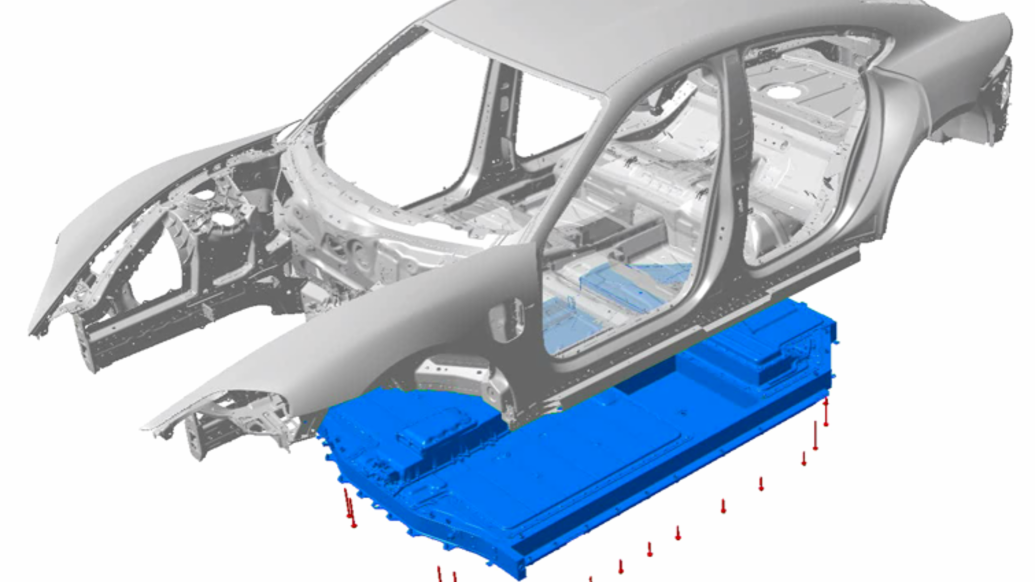
A steel plate protects the battery and the cooling structure against damage from below.
The Taycan’s crash sensors were developed to meet the requirements of an electric vehicle.
Additional sensors reliably disconnect high-voltage equipment in the event of a crash.
If an SRS airbag is deployed the battery is disconnected from the vehicle.
Several high-voltage disconnection points in the vehicle allow emergency services to intervene quickly and safely in the event of an accident.
All fuses and busbars are located centrally in the vehicle. The battery management system, including the disconnection unit, is located in a protected area under the centre console.
Crash-optimised body structure
The Taycan’s body structure has been optimised for safety.
Pedestrians are protected by an active bonnet.
Side impacts are dissipated via both the bodyshell and the structurally integrated high-voltage battery.
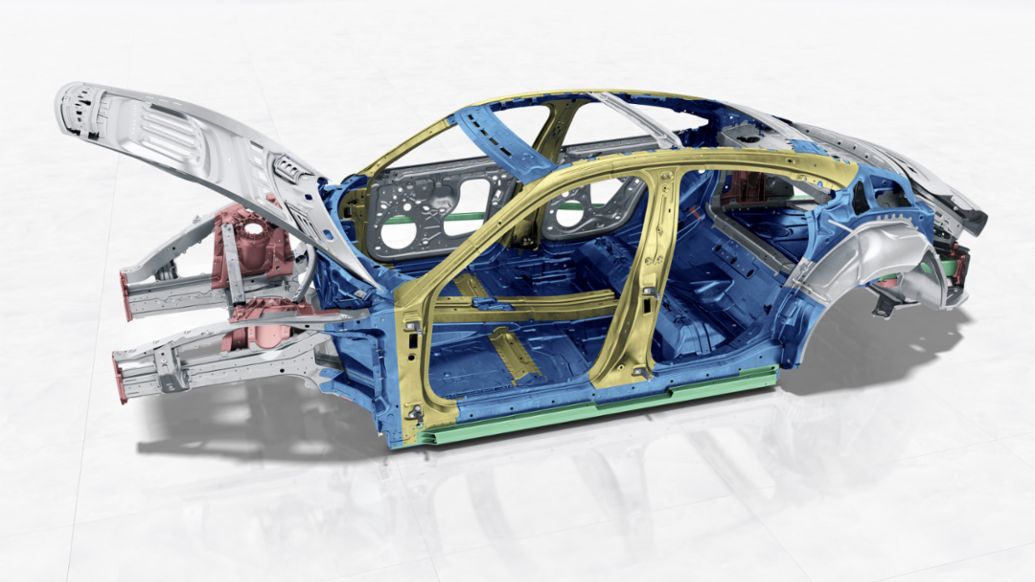
All structural load paths in a rear-end collision are controlled using several features such as optimised geometrical design and specialised casting technology at several structural nodes.
Ten airbags fitted as standard
- Full-size driver and front-passenger airbags
- Knee airbags for the driver and front passenger
- Curtain airbags covering the entire roof frame from the A to the C pillar
- Thorax bags integrated into front-seat side bolsters
- Side airbags in the rear compartment
A list of the Advanced Driver Assistance Systems (ADAS) is provided in a separate section, below.
The ISOFIX mounting system for child seats is fitted on the outer rear seats.
EuroNCAP awarded the Porsche Taycan its top 5-star safety rating in December 2019.
Advanced Driver Assistance Systems
The Taycan features Porsche’s state-of-the-art Advanced Driver Assistance Systems (ADAS). They include:
- Adaptive Cruise Control with Stop & Go (up to 210 km/h)
- Collision Avoidance Assist
- Crossing Assist
- Emergency Assist
- Exit Warning
- Front Turn Assist
- Lane Assist
- Lane Change Assist
- Night View System
- ParkAssistant with Real Top View 3
- Porsche Active Safe
- Traffic Jam Assist
Aerodynamics
The Taycan has the best aerodynamic performance of all current Porsche models, with a Cd value from as low as 0.22 (and up to 0.25).
Its front surface area is 2.33 m2. This results in an effective drag of 0.513 m2.
The Taycan’s outstanding aerodynamics make a significant contribution to low energy consumption and its long driving range.
Achieving these results required extensive 3D CFD simulations (Computational Fluid Dynamics; numerical flow simulation) and around 900 hours in the wind tunnel with a 1:3 model.
The Taycan then spent around 1,500 hours in the wind tunnel.
Air curtains
The Taycan’s headlights appear to float inside large air inlets. These guide air like a curtain over the front wheel housings, reducing turbulence and air resistance.
Flat underbody
It was possible to fully panel the Taycan’s entire underbody due to the lack of any hot exhaust gas
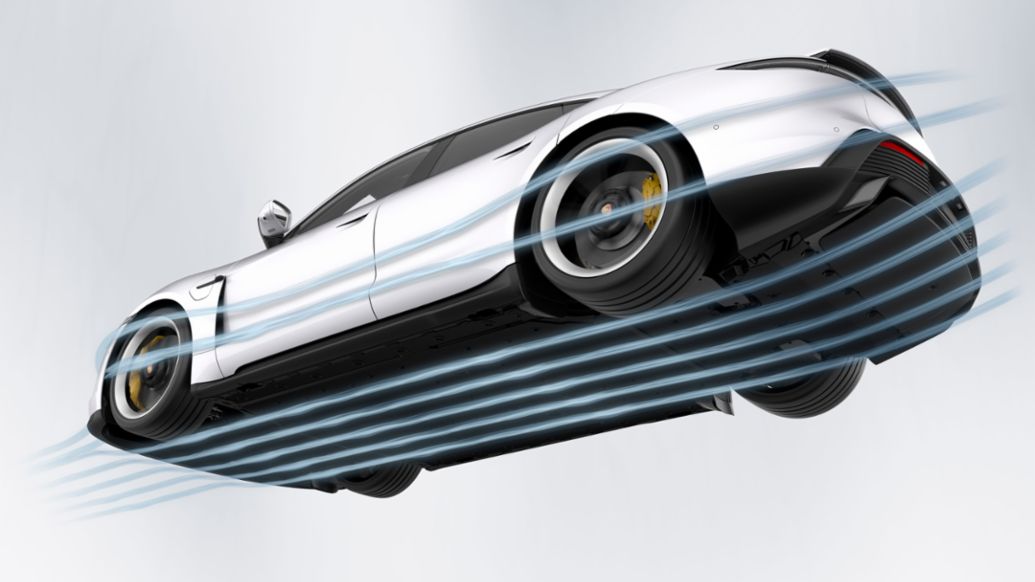
All suspension links are covered and fitted with air ducts.
The extremely wide air diffuser at the rear gives the perfect mix of low drag and reduced lift.
Porsche Active Aerodynamics (PAA)
The Taycan’s active aerodynamic measures include:
- Controllable cooling air flaps:
Located in the lower side air intakes at the front, these supply air to the two radiators at the front, located ahead of each front wheel.
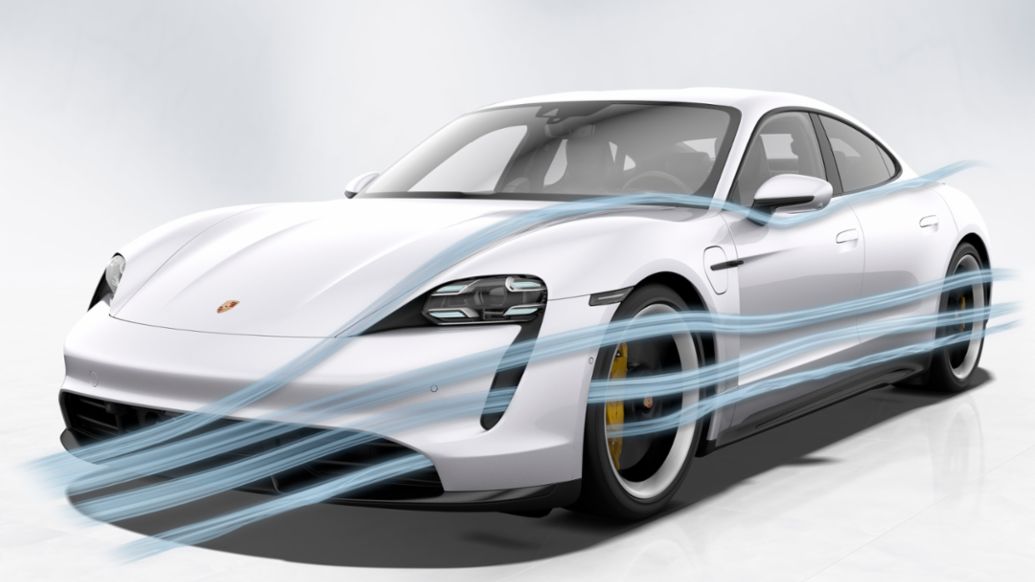
They also control the air flow to the front brakes via the brake air ducts. The chassis control unit monitors the front brakes’ thermal load and delivers targeted air cooling as needed.
When the cooling air flaps are closed, the system reduces drag and increases range.
When the flaps are open, PAA improves the performance of the cooling system and the brakes.
Control of the cooling air flaps is always demand-driven.
- Active rear spoiler:
The rear spoiler extends to three different positions to manage the car’s drag and lift.
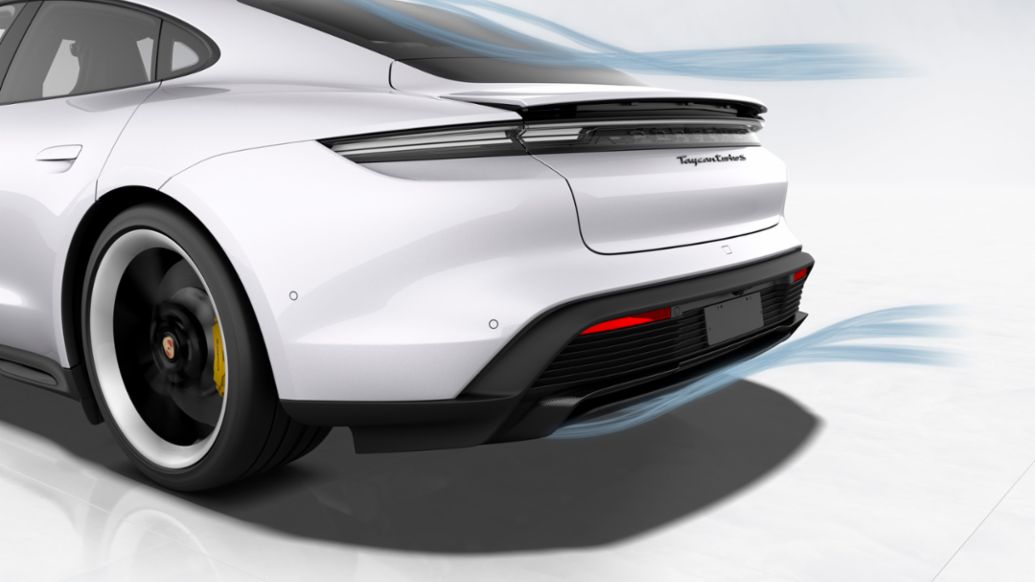
It can adjust to achieve the lowest possible drag, improving efficiency and range.
It can adjust to achieve the lowest possible lift on the rear axle, delivering Porsche sports car performance and fast lap times on a racetrack.
Sound
Porsche has integrated its unmistakeable sound into the Taycan.
It gathered extensive knowledge about sound for electric vehicles when it developed the Le Mans-winning Porsche 919 Hybrid racing car.
This specialist acoustic technology was developed for the Porsche works racing drivers because they needed the sound of a real engine to match what they were doing when training in the team’s race simulator.
For the Taycan, the Porsche Electric Sport Sound makes the vehicle's own drive sound even more emotionally charged and richer with its innovative character – both on the outside and inside.
Disturbing noises from the drive architecture are deliberately minimised and harmonious, emotive sounds matching what the car is doing are amplified.
The Porsche Sport Electric Sound can be activated and deactivated by the driver and meets all country-specific requirements.
The Acoustic Vehicle Alerting System (AVAS), which warns other road users when an electric vehicle is moving at lower speeds, cannot be switched off.
Manufacturing
The Taycan is built at Porsche’s state-of-the-art manufacturing facilities in Zuffenhausen, Germany – the same manufacturing site that produces the 911 and 718 two-door sportscars.
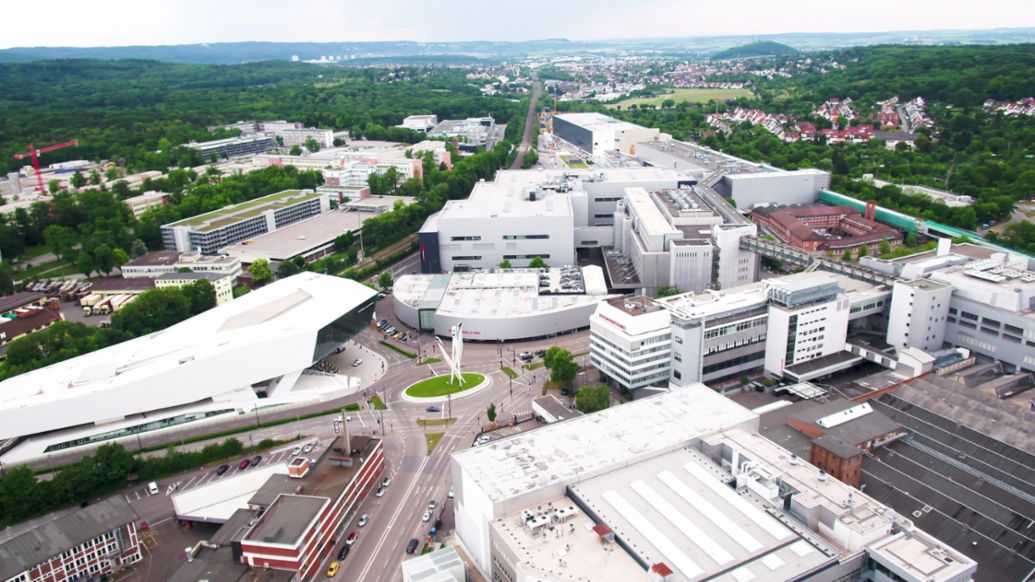
Porsche is targeting CO₂-neutral production of the new Taycan. The following initiatives are helping Porsche achieve this goal:
- Use of power from wind, water and solar energy
- Using renewable sources to power all rail transport of the new cars
- Conversion of heat generation to biogas, which commenced in 2020
Porsche’s investments into electromobility will exceed six billion Euros by 2022.
Glossary of terms
If you would like to learn more about some of the terms used with electric vehicles (EVs) then you can find a helpful glossary of terms here.
Footnotes:
& Access to complimentary Chargefox charging services is subject to customers downloading the Chargefox app and accepting Chargefox’s terms and conditions. Apple App Store is a registered trademark of Apple Inc.
# The published kilometre (km) range figures are determined by Porsche AG testing in accordance with ADR 81/02 on test vehicles assuming the battery is fully charged. Actual figures will vary as they are dependent on many factors, including without limitation: individual driving style, road and traffic conditions, environmental conditions, a vehicle’s or battery’s condition, load and use. Usage of specific features and accessories (eg: vehicle equipment such as air-conditioning, or wheels or tyres used etc.) can change relevant vehicle parameters such as weight, rolling resistance and aerodynamics and can also affect the range and performance values of a vehicle. Generally, kilometre ranges will vary from the published figures in real world Australian driving and charging conditions. Published figures should only be used for the purpose of comparison between vehicles. Please contact an Official Porsche Centre to obtain specific information about vehicles and features.
* PS (PferdeStärke, German for horsepower) is the standard unit used in the European Union to measure the power output of a motor in ‘metric horsepower’.
Note: This technical feature explains features and technology available in the overall Taycan range. For information regarding what specifications are available in each model grade, either as standard or optional equipment, please read our Product Highlights article or visit the Porsche Australian Car Configurator.

